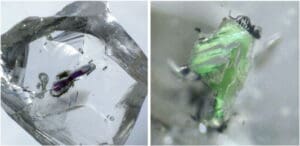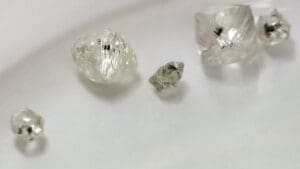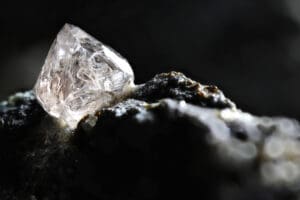Explore the mesmerizing world of diamonds in our in-depth blog, ‘Diamonds: A Deep Dive into Earth’s Treasures.’ Learn about the formation, value, and history of these precious gemstones. Discover their significance in jewelry and investment.
Prestige Pawn & Jewelry, your source for insights on buying and selling jewelry, presents this informative journey into the world of diamonds. Diamonds carry secrets from the depths of Earth, tales through billions of years. In this article we’ll uncover the history of diamonds and their formation into the glittering gems we know today, the story of diamond formation ages.
Imagine this: each diamond begins in darkness, deep beneath our feet. It endures intense heat and pressure over eons before it ever sees light. A journey that’s as mysterious as it is magnificent!
Intriguingly, different diamond ages themselves hold the key to unlock their past! They are geological time capsules carrying clues like mineral inclusions and radiogenic isotopes which help scientists piece together their history.
The Fascinating Journey of Diamond Formation
Glimpse the ancient history of our planet through a diamond’s brilliance. You’re witnessing billions of years of Earth’s history captured in an elegant and eternal form.
The Birthplace of Diamonds: Active Tectonic Regions
Diamonds aren’t born just anywhere; they need very specific conditions to form. Deep beneath the surface, in active tectonic regions where immense heat and pressure exist, diamonds start their journey. In my opinion, these places are akin to geological kitchens where nature cooks up some stunning masterpieces.
In these extreme environments, carbon atoms bond together tightly to create crystal structures – what we know as diamonds. But that’s only part one on this incredible journey.
Diamonds and Ancient Continental Mantle Keels
Ancient continental mantle keels play an important role in protecting our newly formed treasures from destruction during volcanic eruptions. Just like protective cradles or time capsules deep within the earth.
You see, if it weren’t for these structures acting as natural shields for over millions (and even billions) of years, our precious gems might never have survived long enough for us to marvel at them today.
“The oldest tested diamond sample that can be worn as jewelry is billions of years older than dinosaurs.”
Now here’s something fun – imagine wearing something with more than 3 billion candles on its birthday cake? Yes indeed – when you put on a diamond necklace or ring, chances are you’re sporting bling that has seen most parts of Earth’s life story.
Bottom Line:
Diamonds are billions of years old. Imagine that, you’re flaunting a gem over 3 billion years old. These diamonds have been through volcanic eruptions and protected by ancient continental mantle keels for millions of years. They’ve seen most parts of our planet’s history – isn’t that simply awe-inspiring?
The Role of Inclusions in Diamond Dating

Diamonds aren’t always perfect. They contain small flaws or ‘inclusions’. But don’t let their name fool you – these inclusions are far from insignificant. Instead, they hold key information that helps us figure out how old the diamonds really are.
You see, as diamonds form deep within Earth’s mantle over billions of years, minerals surrounding them can get trapped inside. These captured guests act as time capsules preserving details about the conditions when and where the diamond formed. Scientific studies have shown that uranium, samarium, rhenium, and rubidium isotopes present in these mineral samples offer some of our best clues to determine a diamond’s absolute age.
Syngenetic vs Preexisting Inclusions
Inclusion examination gets even more fascinating when you realize there are two types – syngenetic and preexisting. Syngenetic inclusions were engulfed by growing diamonds while preexisting ones already existed before being swallowed up during growth stages. Syngenetic inclusions, those formed at the same time as the diamond, give us direct information about when and how our shiny friends came to be. On the other hand, pre-existing inclusions, formed before their host diamonds, tell tales of a pre-diamond era.
The process of identifying and studying these microscopic hitchhikers, however, is no easy task. Diamond dating requires breaking mineral inclusions out for analysis – a necessary but destructive technique to unlock their history. Research shows this method has proven extremely effective at providing insights into our planet’s geological past.
Bottom Line:
The study of diamonds is not just about their beauty or value, but also their ability to shed light on the geological processes that shaped Earth over billions of years. Despite the challenges in analysis, this painstaking work uncovers hidden stories etched deep within these sparkling gems.
The Destructive Technique of Diamond Dating
Diamond dating, while sounding glamorous, is not for the faint-hearted. It involves a somewhat destructive technique that lets us peek into a diamond age and ancient past.
Let me paint you a picture: Imagine being handed an antique book with no publication date. To find out when it was printed, you’d need to look at the clues within its pages. Diamonds are much like these books; their secrets are held deep inside them.
Ever wondered about the history locked inside a diamond? Just like an antique book, each gemstone carries a story of its own. The tool we use to unlock this narrative is radiogenic isotope analyses to date these ancient minerals.
The Intricacies of Inclusion Extraction

So how do we get to these hidden narratives? Well, this is where things get messy but also fascinating. We use inclusions – tiny mineral deposits trapped inside diamonds during their formation process as our guides.
The mineral inclusions are a rich source of knowledge. They show us how diamond formation is tied to plate tectonic activities and uncover limits on when fluid mobile compounds can be recycled.
Analyzing these time capsules though requires extracting them from the diamond which can result in breakage. But hey, who said learning about billions of years’ worth history would be easy?
An Essential Trade-Off
Yes indeed – there’s always a cost associated with knowledge and insight. Just like peeling layers off an onion might make your eyes water but gets you closer to its core, so does breaking open these gems reveal more about their billion-year journeys. GIA’s article on Deep Focus Diamonds gives detailed insights into this process.
Bottom Line:
Diamond dating is a fascinating, albeit destructive process. It involves examining inclusions – tiny mineral deposits within diamonds that offer clues about their formation ages. Breaking open these gems can reveal billion-year-old stories but also risks damaging them. This exploration helps us understand two types of inclusions: syngenetic and pre-existing, each offering unique insights into Earth’s geological history.
Diamonds and Plate Tectonics
The story starts deep beneath the Earth’s surface. The intense heat and pressure in these areas create diamonds from carbon-containing minerals. But it doesn’t stop there.
This precious gemstone travels through time before landing in your favorite piece of jewelry. And plate tectonics play a significant role in this fascinating journey.
Recent research shows that movements and collisions between Earth’s plates have contributed to bringing diamonds closer to the surface over geological timescales. Think about how thrilling it is. Your diamond could’ve once been part of an ancient landmass that no longer exists now.
From Carbon to Diamonds: A Tectonic Tale
In active tectonic regions where plates meet or diverge under extreme pressure and temperature conditions, carbon atoms crystallize into what we know as diamonds.
But this process isn’t one-sided. Just as Earth gives birth to diamonds, these gems give back by aiding in the recycling of fluid mobile compounds and elements within our planet’s deep mantle.
The Deep Timekeepers

Diamonds function like time capsules, preserving a record of Earth’s geological past within their crystal structure. By studying these precious stones, scientists can get insights into processes that occurred over three billion years ago. Talk about going back to ancient times.
Diamond ages, obtained through scientific methods such as radiogenic isotope analyses, help us understand not just when they were formed but also how tectonic activities have evolved throughout Earth’s history.
Bottom Line:
So next time you’re admiring a diamond, remember it’s not just a beautiful stone. It’s also an ancient storyteller that offers us glimpses into Earth’s deep history and the massive tectonic activities shaping our planet over billions of years.
FAQs in Relation to Diamond Formation Ages
What is the age of diamond formation?
Diamonds form over billions of years, with some dating back more than 3 billion years.
How can you tell how old a diamond is?
Scientists use radiogenic isotopes and study mineral inclusions trapped within diamonds to determine their ages.
How old is the youngest diamond?
The ‘youngest’ known natural diamonds are about 900 million years old, showing that these gems truly stand the test of time.
How many years does it take for a diamond to form?
A typical diamond needs at least one billion to three billion years to fully form deep within Earth’s mantle.
Conclusion
Diamond formation ages are a treasure trove of knowledge, aren’t they?
They unravel the mysteries deep within our planet. They give us insights into active tectonic regions and ancient continental mantle keels.
We’ve dived into radiogenic isotope analyses, peeking back billions of years. We’ve seen how mineral inclusions – syngenetic and preexisting alike – hold clues to their birthdate.
Our journey traced diamonds through time, explored fluid mobile compound recycling in the deep earth, all while recognizing these sparkling gems as vital geological tools.
Now you see: every glint from a diamond carries echoes from eons past!
Sources:
Jessica. “✨ Geological Origin of Natural Diamonds.” GSI: Gemological Science International, 26 Nov. 2021, gemscience.net/geological-origin-of-natural-diamonds/.
Karen V. Smit and Steven B. Shirey. “Diamonds from the Deep: How Old Are Diamonds? Are They Forever?” Gems & Gemology, www.gia.edu/gems-gemology/spring-2019-how-old-are-diamonds-are-they-forever#item-5. Accessed 7 Dec. 2023.
Pay, Duncan. “Tiny Inclusions Reveal Diamond Age and Earth’s History: Research at the Carnegie Institution.” Research & News, 31 Jan. 2014, www.gia.edu/UK-EN/gia-news-research-tiny-inclusions-reveal-diamond-age.
Smith, Evan M. “Deep-Focus Earthquakes: The Heartbeat of a Diamond Factory?” Gemological Institute Of America, www.gia.edu/gems-gemology/spring-2022-diamond-reflections-deep-focus-earthquakes-heartbeat-diamond-factory. Accessed 7 Dec. 2023.
Shah, Dhvanit I., et al. “Correction: Corrigendum: Mitochondrial ATPIF1 Regulates Haem Synthesis in Developing Erythroblasts.” Nature News, Nature Publishing Group, 17 Apr. 2013, www.nature.com/articles/nature12078.
T. Stachel a, et al. “The Origin of Cratonic Diamonds – Constraints from Mineral Inclusions.” Ore Geology Reviews, Elsevier, 22 Apr. 2008, www.sciencedirect.com/science/article/abs/pii/S0169136808000176.

